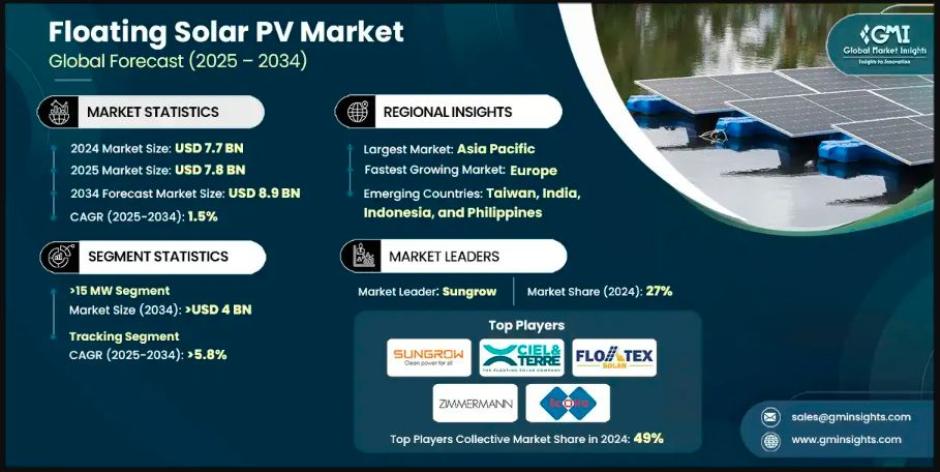The global floating solar PV market was valued at USD 7.7 billion in 2024 and is projected to grow from USD 7.8 billion in 2025 to USD 8.9 billion by 2034, registering a CAGR of 1.5 percent, according to Global Market Insights report.
Sungrow leads the floating solar PV market with a 27 percent share, while top players including Sungrow, Ciel & Terre, Floatex Solar, Zimmermann, and Scotra collectively account for 49 percent of the 2024 market.
Growth in the floating solar PV market is being driven by Asia-Pacific countries such as China, India, Indonesia, and Thailand, supported by favorable policies and geographic advantages. In Europe and North America, the adoption is increasing through integration with hydropower infrastructure and exploration of offshore floating solar applications.
Floating solar PV systems utilize lakes, reservoirs, and ponds, helping to conserve land resources—a key benefit in densely populated areas. A notable example is Thailand’s 31 MW floating solar plant, which combines solar, hydro, and energy storage systems, cutting CO₂ emissions by 41,000 tons annually and powering around 18,000 households.
The cooling effect of water enhances solar panel efficiency, while government incentives and renewable energy targets are accelerating adoption. Furthermore, hybrid projects—such as Ocean Sun’s 2 MW FPV collaboration with NHPC Limited in India—highlight the growing synergy between solar and hydropower generation, optimizing energy output without additional land use.
The floating solar PV market is witnessing steady diversification across system sizes and regions, driven by rising renewable energy adoption and land-use optimization goals.
5 MW floating solar PV systems are expected to grow at over 2 percent CAGR through 2034, supported by their suitability for small-scale, decentralized applications such as wastewater treatment plants, reservoirs, and agricultural ponds. The 5–15 MW segment, which accounted for 8.1 percent of the market in 2024, is projected to exceed 10 percent share by 2034, as these mid-sized systems balance scalability and manageability, appealing to local governments and utilities seeking efficient renewable solutions.
Regionally, the U.S. market grew from USD 10 million in 2022 to USD 16 million in 2024, representing 0.3 percent of global share. States like New Jersey and California are driving adoption through incentives and renewable energy integration. Key projects include Third Pillar’s 500 MW floating solar development with Diamond Infrastructure Solutions.
In Europe, the market is projected to reach USD 650 million by 2034, spurred by large-scale projects and advancements in floating structures, mooring systems, and panel technologies. A notable example is Q ENERGY and Velto Renewables’ 74.3 MW Les Ilots Blandin project in France, which will prevent 18,000 tons of CO₂ emissions annually.
The Asia-Pacific region remains the dominant market, expected to exceed USD 7.2 billion by 2034, fueled by land scarcity, rising power demand, and strong government support. Countries such as China, India, Vietnam, and Thailand are leading large-scale hybrid solar-hydro initiatives.
Emerging regions like Latin America and the Middle East & Africa, holding 2.3 percent and 1.9 percent market shares respectively, are expanding through pilot-scale floating solar and hybrid hydropower projects. For instance, the African Export-Import Bank is financing a 1 GW floating solar PV plant in Zimbabwe, featuring a 500 MW pilot phase under a 20-year PPA, signaling growing investment interest in sustainable energy infrastructure.
The global floating solar PV market is becoming increasingly competitive, led by top players such as Sungrow Power Supply, Ciel & Terre, Zimmermann, Scotra, and Floatex Solar. Growth is being driven by rising renewable energy adoption, technological advancements, and the need for sustainable land use. Established solar manufacturers and specialized FPV firms are expanding operations worldwide, with competition intensifying across Asia-Pacific, Europe, and emerging markets due to government incentives, cost reductions, and innovation.
Ciel & Terre International, known for its Hydrelio floating platform, operates in over 30 countries and has implemented 250+ projects totaling 1.2 GW of FPV capacity by 2025.
Sungrow Power Supply, with USD 10.8 billion in 2024 revenue, is a major player in China and Southeast Asia, integrating inverters and energy storage with FPV systems.
LONGi, reporting USD 11.4 billion in 2024 revenue, is integrating high-efficiency monocrystalline modules into FPV systems to improve energy yields in land-constrained regions.
Trina Solar, with USD 11.15 billion in 2024 revenue, is expanding in Asia-Pacific and Europe and involved in major projects like a 500 MW battery storage system in Australia.
Kyocera Corporation, generating USD 13.83 billion in 2024 revenue, has been pioneering FPV projects in Japan, focusing on efficient integration of its solar modules with floating platforms.
Canadian Solar, through its Recurrent Energy arm, has developed over 10 GW of solar projects and 3.3 GWh of battery storage globally, supporting diversification into floating solar.
Recent industry developments highlight the market’s momentum:
In October 2025, Indonesia’s PLN began building a 92 MW floating solar plant in West Java, part of a broader plan to add 42.6 GW of renewables by 2034.
In June 2024, Ghana launched a 5 MW floating solar plant at the Bui reservoir, Africa’s largest FPV project, reinforcing the country’s clean energy leadership.
In December 2023, China Three Gorges International connected a 700 GWh FPV project in Anhui Province, saving 220,000 tonnes of coal and cutting 580,000 tonnes of CO₂ annually.
In July 2022, Ciel & Terre India completed the 73.4 MW NTPC floating solar plant in Kerala, India’s first backwater FPV installation, with all floats manufactured locally.
Overall, the FPV market is evolving rapidly, with expanding regional deployment, hybrid solar-hydro models, and stronger integration of energy storage solutions shaping the next phase of global growth.
Baburajan Kizhakedath

